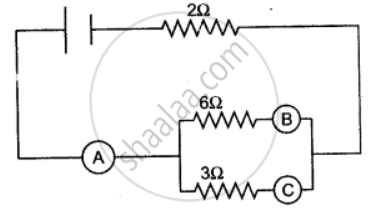Advertisements
Advertisements
Question
A cell of e.m.f 2.0 V and internal resistance 1Ω is connected to the resistors of 3Ω and 6Ω in series. Calculate:
(i) the current drawn from the cell,
(ii) the p.d. across each resistor,
(iii) the terminal voltage of the cell and
(iv) the voltage drop.
Solution
Total resistance of the circuit R = 1 + 3 + 6 = 10 Ω
(i) The current drawn from the cell = `"E"/"R" = 2.0/10 = 0.2` A
(ii) The p.d. across 3 Ω resistor V1 = IR1 = 0.2 × 3 = 0.6V
The p.d. across 6 Ω resistor V2 = IR2 = 0.2 × 6 = 1.2 V
(iii) The terminal voltage of the cell V = V1 + V2
= 0.6 + 1.2 = 1.8 V
(iv) The voltage drop = E - V = 2.0 - 1.8 = 0.2 V
APPEARS IN
RELATED QUESTIONS
You have three resistors of values 2Ω, 3Ω and 5Ω. How will you join them so that the total resistance is more than 7Ω?
1) Draw a diagram for the arrangement
2) Calculate the equivalent resistance.
By what other name is the unit joule/coulomb called?
Define one coulomb charge.
Name a device that help to measure the potential difference across a conductor.
Keeping the resistance constant, the potential difference applied across the ends of a component is halved. By how much does the current change?
Keeping the potential difference constant, the resistance of a circuit is doubled. The current will become:
Draw a graph of Potential difference (V) versus Current (I) for an ohmic resistor. How can you find the resistance of the resistor from this graph?
In the figure given below, A, B and C are three ammeters. The ammeter B reads 0.5A. (All the ammeters have negligible resistance.)

Calculate:
(i) the readings in the ammeters A and C.
(ii) the total resistance of the circuit.
A current of 100 mA. flows through a wire. The charge on an electron is 1.6 × 10-19 C. Find the number of electrons passing per second through the cross-section of the conductor.
Conceptual question.
A bird sitting on a high power electric line is still safe. How?
